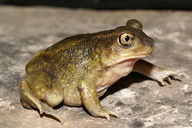|
Scaphiopus hurterii Strecker, 1910
Hurter's Spadefoot | family: Scaphiopodidae genus: Scaphiopus |
 © 2007 Stanley Trauth (1 of 1) |
|
|
Country distribution from AmphibiaWeb's database: United States
U.S. state distribution from AmphibiaWeb's database: Louisiana, Oklahoma
Scaphiopus hurterii Strecker, 1910 Editor's note: While we follow Crother et al. (2000) and consider Hurter's spadefoot toads (Scaphiopus hurterii) to be a distinct species, they historically have been considered a subspecies of eastern spadefoot toads (Scaphiopus holbrookii). The range of Hurter's spadefoot toads is from eastern extensions in central Louisiana west to the Balcones Escarpment of the Edwards Plateau, and from northern populations in eastern Oklahoma and western Arkansas south to the Rio Grande (Wasserman, 1968). The Mississippi River generally separates Hurter's spadefoot toads from eastern spadefoot toads, however, populations of eastern spadefoot toads occur west of the Mississippi River in Arkansas and Missouri. Hurter's spadefoot toads and eastern spadefoot toads will interbreed (Wasserman, 1957, 1958), and because most aspects of their ecology are similar, features of their life history and natural history are covered under the Scaphiopus holbrookii account (Palis, this volume). There is at least one noted difference between these species—Hurter's spadefoot toad tadpoles readily take live invertebrate prey, including mosquito (dipteran) larvae and fairy shrimp (Anostraca; Bragg, 1962b). Literature references for Amphibian Declines: The Conservation Status of United States Species, edited by Michael Lannoo, are here. Feedback or comments about this page.
Citation: AmphibiaWeb. 2025. <https://amphibiaweb.org> University of California, Berkeley, CA, USA. Accessed 23 May 2025. AmphibiaWeb's policy on data use. |




 Map of Life
Map of Life